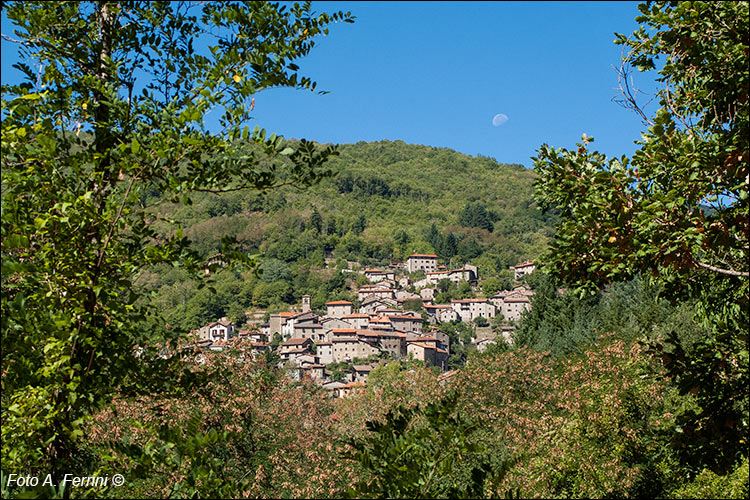La Casetta di Buite e il percorso di Hinkler
un itinerario in Pratomagno, il massiccio tra Casentino e Valdarno
Italiano
RAGGIOLO, BORGO DEI CORSI
Questo trekking in Pratomagno può essere l’occasione per visitare antichi borghi di straordinario fascino costruiti sulle rovine di castelli medievali. Uno di questi è Raggiolo, a dieci chilometri da Bibbiena e dall’Arno. In questo caso è necessario allungare qualche chilometro il percorso in auto perché giunti a Ortignano, dove dovremmo voltare a destra per dirigersi verso Quota e il Pratomagno, proseguiamo dritto. In quattro chilometri arriviamo a Raggiolo, a 630 metri di altitudine. Le origini di questo borgo possono datarsi VII secolo quando i longobardi ebbero qui un loro insediamento. La storia importante e documentata di Raggiolo inizia nel XIII secolo, quando i Conti Guidi vi costruirono un loro castello. Alla metà del secolo successivo il luogo passò sotto il dominio della Repubblica Fiorentina. Nel 1440 il castello fu completamente distrutto delle truppe di Niccolò Piccinino, un capitano di ventura al servizio dei Visconti di Milano. Nella seconda metà del Cinquecento iniziò per Raggiolo una lenta ricostruzione che in qualche secolo lo porterà a diventare un grande paese adagiato sulle scoscese pendici della montagna. Visitarlo significa camminare sui sali scendi di stretti vicoli tra curatissimi edifici, quasi tutti senza fondamenta perché costruiti direttamente sulla roccia. Da vedere è la chiesa dedicata a San Michele Arcangelo, vi sono conservate opere di buon valore artistico. Inoltre, è presente l’Ecomuseo della Castagna: in vari locali è raccontata la storia del paese, in particolar modo quella legata a questo frutto, fino a qualche decennio fa fondamentale per l’economia del luogo. Per conoscere dettagliatamente Raggiolo visita questa sezione web. This trekking in Pratomagno can be an opportunity to visit ancient villages of extraordinary charm built on the ruins of medieval castles. One of these is Raggiolo, ten kilometers from Bibbiena and the Arno. In this case it is necessary to lengthen the route by car a few kilometers because once in Ortignano, where we should turn right to head towards Quota and Pratomagno, we continue straight on. In four kilometers we arrive in Raggiolo, at an altitude of 630 meters. The origins of this village can date back to the seventh century when the Lombards had their settlement here. The important and documented history of Raggiolo begins in the 13th century, when the Guidi Counts built their castle there. In the middle of the following century the place passed under the dominion of the Florentine Republic. In 1440 the castle was completely destroyed by the troops of Niccolò Piccinino, a mercenary captain in the service of the Visconti of Milan. In the second half of the sixteenth century a slow reconstruction began for Raggiolo which in a few centuries will lead it to become a large town nestled on the steep slopes of the mountain. Visiting it means walking on the ups and downs of narrow alleys between well-kept buildings, almost all without foundations because they are built directly on the rock. Worth seeing is the church dedicated to San Michele Arcangelo, there are preserved works of good artistic value. In addition, there is the Chestnut Ecomuseum: the history of the town is told in various places, especially that linked to this fruit, which was fundamental for the local economy until a few decades ago. To learn more about Raggiolo, visit this web section.

















































































